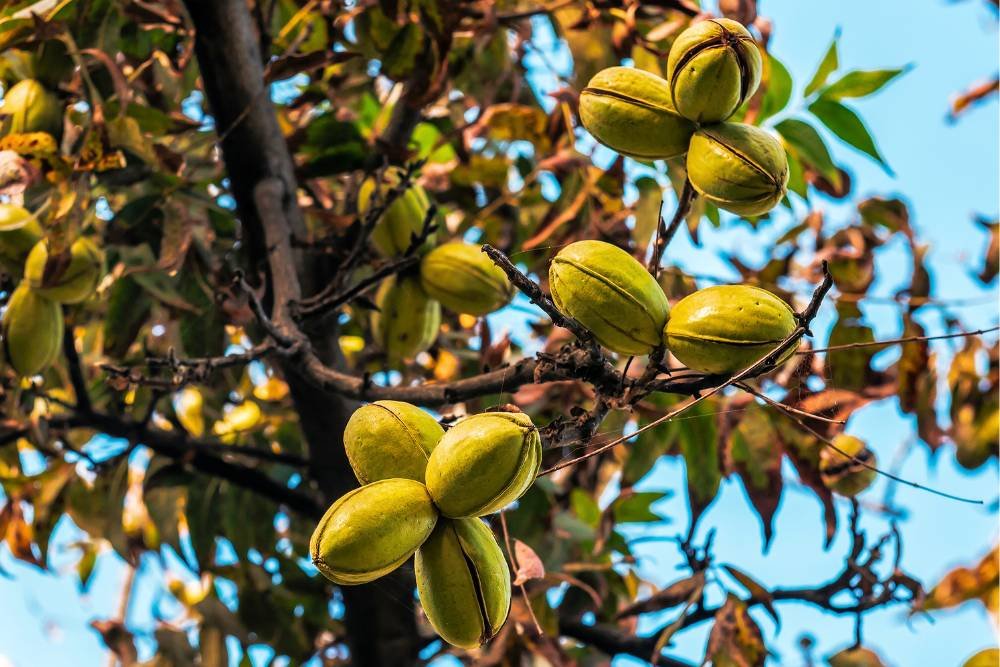How an RAS exhibitor cracked a tough nut
Who would have guessed, over 100 years ago, that an exhibitor at the Royal Show in Pietermaritzburg would ultimately be responsible for starting an industry that has seen South Africa become the world’s third-largest pecan producer after the United States and Mexico?
INTERESTING FACT
The pecan “nuts” we know and love are not technically nuts, but are actually stone fruits or drupes, just like apricots, olives, peaches, plums, cherries and mangoes.
The Royal Agricultural Society, Queen Elizabeth II’s great-aunt, the Algonquin Native Americans, dinner in Durban harbour, Willow Fountain, the Ukulinga Research Farm at UKZN, and Frances Staniland Drive in Pietermaritzburg — you wouldn’t imagine that these are all linked to how pecan nut growing came to be established across South Africa.
It was originally only the Native Americans, in what is now the southern United States and northern Mexico, who were able to enjoy pecans (a word of Algonquin origin that was used to describe “all nuts requiring a stone to crack”).
Cultivating pecan nuts elsewhere was indeed a tough nut to crack, as the many different varieties of trees are slow to mature, and are prone to insect, bacterial and fungal infection, particularly in humid conditions. Successful propagation also often relies on a technically difficult grafting process. As a result, pecans are one of the most recently domesticated commercial crops, and commercial growing only began in the southern United States in the 1880s.
South Africa’s success in cultivating pecans not long after this largely originates with one Natal settler family in Pietermaritzburg, who regularly exhibited their pecans at the Royal Show.
Ruth Gordon, who chronicled the Royal Agricultural Society’s history in Natal’s Royal Show (1984), tells the fascinating story of Mrs Frances Stafford Staniland (1868–1963), who exhibited at the Royal Show well into her nineties. Frances was famous for two things: her spectacular crochet creations, and her pecan nuts harvested from her family’s orchard — the first pecan orchard in South Africa.
Frances Staniland was instrumental in establishing this first pecan orchard after her husband, Frank (who owned a stevedoring company in Durban harbour in the early 1900s), came into contact with a particular ship’s captain. Gordon describes how
Mr Staniland thus first tasted pecan nuts while dining on board an American ship with the captain in the Durban harbour before the first World War. The captain promised to send him some to experiment with. Finally, an order to Wight Bros of Cairo, Georgia, resulted in a batch of little trees in tins being sent out by ship [in 1912] and then planted at Willow Fountain, the scene of the 1880 pioneer settlement. The instructions were to plant them at least 60 feet apart. Everyone laughed, and to their later regret they spaced them only 40 feet apart (Gordon, 1984, p. 95).
After her husband’s death in 1926, Frances teamed up with her daughter, Joyce, and son, Eric (who was sent to Georgia in the United States to study pecan cultivation and propagation), to establish the first nursery of budded and grafted trees. These trees were sent all over South Africa, “including batches to Hall’s at Matafin” in Nelspruit, now one of South Africa’s largest pecan producers and pack houses.
In the 1950s, Eda Glass, another one of the Staniland daughters, was closely involved with breeding new local varieties and participated in Field Days held by the University of Natal’s Faculty of Agriculture. One of these varieties, Ukulinga (meaning ‘to test’ or ‘to endeavour’ in isiZulu), was named after the Ukulinga Research Farm established in 1950 by the University of Natal.
Ukulinga pecans are slightly smaller than average, and have a harder shell, but are able to flourish in KwaZulu-Natal’s humid conditions as they are resistant to scab infections. Those pecan trees in KZN gardens that have been able to survive the invasive shot hole borer beetle and the explosion of the monkey population of late, are most likely Ukulingas.
Gordon describes how “Mrs Staniland and her daughter, Joyce, regularly sent pecan nuts to the Royal Show from the 1930s until the late 1950s. She was a friend of Princess Alice [the Countess of Athlone, and wife of the Earl of Athlone, the Union of South Africa’s Governor-General from 1924–1931] to whom she often sent gifts of pecan nuts. Frances Staniland Road, in Pietermaritzburg’s Montrose suburb, is named in her honour” (Gordon, 1984, pp. 94–95).
Thanks to the early efforts of Frances Staniland and her children, successful pecan nut cultivation has since taken root in all of South Africa’s nine provinces. The South African pecan nut industry, while still young and developing (in agricultural terms), is now expanding through the efforts of the South African Pecan Nut Producers’ Association (SAPPA), which formed in 2012. SAPPA provides technical information and support to existing and prospective growers (https://www.sappa.za.org/).
So, when you next enjoy your pecan nut treats and sweetmeats at Christmas, Diwali and Eid, or when you feel the need to boost a salad to glorious heights, remember this Royal Agricultural Society exhibitor and the gift she bestowed on all of us.



